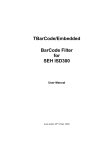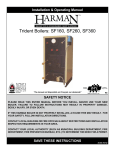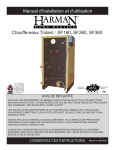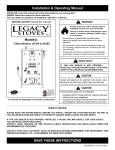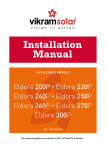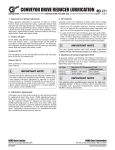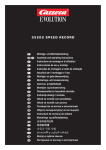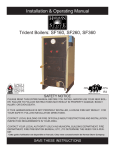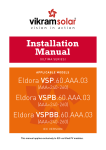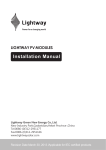Download S-Series 140 W ~160 W CIS Photovoltaic Module Installation Manual
Transcript
Title/ 書名 S-Series 140 W ~160 W CIS Photovoltaic Module Installation Manual 3rd Edition, October 2012 www.solar-frontier.com Disclaimer This manual is the proprietary information of Solar Frontier K.K. (hereafter referred to as Solar Frontier). Solar Frontier’s Limited Warranty Certificate for PV modules will be voided if the instructions here within are not strictly observed. Solar Frontier will not assume any liability for damage arising from improper use, installation, operation or maintenance. Solar Frontier reserves the right to make amendments to the contents of this document without prior notice. This conforms to certification as set out by IEC 61646 , 61730 -1/2 and UL 1703. This manual is valid as of October 2012. It replaces all previous changes made to this document. © Solar Frontier K.K. IMS3-210-PGE41 SAB12_0351_03_Installation_and_Maintenance_Guide Contents About this manual 4 General Safety 4 4 4 5 5 5 6 7 8 9 Mechanical Installation Electrical Installation Storage and transport 9 General information Technical data Electrical characteristics Performance at low irradiance Thermal characteristics Characteristics for system design Mechanical data Module drawing 9 10 10 11 11 14 Site location Module handling Module mounting Mounting with screws Mounting with clamps Clamp specifications 15 15 16 Grounding Electrical wiring Operation17 Maintenance17 Disposal18 About Solar Frontier 18 3 About this manual Thank you for choosing Solar Frontier’s CIS photovoltaic (PV) modules. At Solar Frontier, we look forward to providing you with the highest standards in solar energy performance and customer service. The following manual contains vital information on handling, installing, wiring, operating and maintaining Solar Frontier PV modules, and the associated risks thereof. It is essential that you understand all the instructions and warnings thoroughly, together with any information provided by balance of system manufacturers, to ensure the correct and safe use of our modules. Please share this document with the installer/operator and keep it for future reference. BE SURE TO CONFORM TO ALL RELEVANT LOCAL AND NATIONAL LAWS, REGULATIONS AND CODES WHEN INSTALLING, WIRING, OPERATING AND MAINTAINING SOLAR FRONTIER PV MODULES. If you have any additional queries, please contact your local supplier or Solar Frontier directly. General information Solar Frontier’s CIS modules generate an electrical direct current when exposed to sunlight. They are designed for terrestrial use. The nominal power of Solar Frontier PV modules indicates the power generated under Standard Test Conditions (module temperature: 25 °C, air mass 1.5, solar irradiance 1,000 W/m2). Module power output in actual operating conditions may vary. The amount of electrical direct current generated is proportional to irradiance intensity, while the voltage is subject to change according to temperature. Technical data The technical data below represents modules distributed in all regions. UL Specific Instructions Information required by UL is shown in these boxes and is only relevant to US installers. Electrical characteristics Electrical Data at Standard Test Conditions: 25 °C, AM 1.5, 1,000 W/m2 (UL: per ASTM E892) Maximum power Pmax SF140-S SF145-S SF150-S SF155-S SF160-S 140 W 145 W 150 W 155 W 160 W Tolerance of Pmax +10% / -5% Open circuit voltage Voc 107 V 107 V 108 V 109 V 110 V Short circuit current Isc 2.10 A 2.20 A 2.20 A 2.20 A 2.20 A Voltage at maximum power Vmpp 80.5 V 81.0 V 81.5 V 82.5 V 84.0 V Impp 1.74 A 1.80 A 1.85 A 1.88 A 1.91 A Open circuit voltage at -10 °C and 1,250 W/m (UL) 120 V 120 V 121 V 122 V 123 V Short circuit current at 75 °C and 1,250 W/m (UL) 2.64 A 2.76 A 2.76 A 2.76 A 2.76 A Current at maximum power 2 2 Photovoltaic modules may produce more current and/or voltage under actual operating conditions than in Standard Test Conditions. This is due to the unique CIS property of “light4 soaking”, which results in higher energy output due to an increase in fill factor. The electrical characteristics are within ±10% of the indicated values of Isc and Voc under STC. The power output stated on the label is measured at the plant after module preconditioning. The values of Isc and Voc marked on the modules should be multiplied by a factor of 1.25 to determine component voltage ratings, conductor ampacities, overcurrent device ratings, and size of controls connected to the module output. UL Specific Instructions Refer to Section 690.8 of the National Electrical Code for an additional multiplying factor of 125 percent (80 percent derating). Installation must be completed in accordance with CSA C22.1, Safety Standard for Electrical Installations, Canadian Electrical Code, Part 1. Electrical data at Nominal Operating Cell Temperature Conditions (NOCT 47 °C) SF140-S SF145-S SF150-S SF155-S SF160-S Maximum power Pmax 104 W 108 W 111 W 115 W 119 W Open circuit voltage Voc 97.4 V 97.4 V 98.3 V 99.2 V 100 V Short circuit current Isc 1.68 A 1.76 A 1.76 A 1.76 A 1.76 A Voltage at maximum power Vmpp 75.5 V 76.0 V 76.4 V 77.4 V 78.8 V Current at maximum power Impp 1.38 A 1.43 A 1.47 A 1.49 A 1.51 A Performance at low irradiance Efficiency reduction of maximum output from an irradiance of 1,000 W/m2 to 200 W/m2 at 25 °C is typically 2.0%. The standard deviation for the reduction in efficiency is 1.9%. Thermal characteristics NOCT 47 °C Temperature coefficient of Isc α +0.01 % / K Temperature coefficient of Voc β -0.30 % / K Temperature coefficient of Pmax δ -0.31 % / K Maximum system voltage Vsys 1000 / 600 V DC (UL) Limiting reverse current Ir 7A Maximum series fuse rating Isf 4A Characteristics for system design * The sum of Voc of series modules must not exceed the maximum system voltage of the module under any circumstances, even at low temperature. ** Reverse current applied to the modules must never exceed 7A under any circumstances. UL: Modules installed in parallel will be provided with the listed maximum series fuse, as specified. 5 Mechanical data Dimensions (L x W x H) 1,257 x 977 x 35 mm (49.5 x 38.5 x 1.4 in) Weight 20.0 kg (44.1 lbs) / 16.3 kg/m2 (3.3 lbs/ft2) Module operating temperature -40 °C to 85 °C Application class on IEC 61730 Class A Fire safety class on IEC 61730 Class C Cable 2.5 mm2 / 14 AWG (halogen free) Snow Load (to the front of the module) 2,400 Pa (IEC 61646) / 1,600 Pa design* load (UL 1703) Wind Load (to the back of the module) 2,400 Pa (IEC 61646) / 1,600 Pa design* load (UL 1703) * UL: 1.5 times design load is applied to the module. Accordingly, 2,400 Pa (50 lbs/ft2) is loaded to test the 1,600 Pa (33.5 lbs/ft2) UL design load. The fire rating is applicable for mounting instructions specified in the following Mechancial Installation. 6 Module drawing 1257±2 (49.5±0.1) A 568.5±5 (22.4±0.2) 90 (3.5) 977±2 (38.5±0.1) 444(17.48) (see cross section below) 431.5±5 (17±0.2) 440±5 (17.3±0.2) 454.5 (17.9) 372.5 (14.7) 2x Ø4 (0.2) 454.5 (17.9) 372.5 (14.7) Grounding holes Mounting holes (—) 120 (4.7) Junction box 8x Ø6.6 (0.25) Mounting holes 65 (2.6) (548.5) [21.6] 598.5±5 (23.6±0.2) 4x Ø8.5 (0.3) (+) 33.5 (1.3) Label (50) [1.9] 150 (5.9) 86.6 (3.4) 225 (8.9) 1200±100 (47.2±3.9) 465±5 (18.3±0.2) 30 (1.2) Sealant Cover glass Cell Encapsulant Back sheet Frame 12 (0.5) 35 (1.3) A cross section 35 (1.3) 13.5 (0.53) 31±1 (1.2±0.04) 21.5 (0.9) 225 (8.9) 934±2 (36.8±0.1) 31±1 (1.2±0.04) B (see cross section below) 21.5 (0.9) 35±0.5 (1.3±0.02) Screw 28.2 (1.1) Bar code label B cross section 30 (1.2) Diagram No. DAB12-0039 Measurements are shown in millimeters (figures in brackets are measurements in inches). 7 General Safety WARNING Observe all applicable health and safety regulations when installing Solar Frontier modules. A safe distance should be cordoned off around the installation area. Fall protection equipment must be used. Installations in windy or wet conditions require additional precautions. Please follow local safety regulations. Keep Solar Frontier PV modules out of reach of children. Please ensure all necessary measures are taken to prevent accidents. The use of Solar Frontier modules in applications that may endanger human lives is prohibited, including air and road transport systems. Solar Frontier modules must not be used for anything other than their express purpose. Solar Frontier advises all involved parties to strictly follow the guide below to avoid damage to property, bodily injury or death. Installation, wiring, and maintenance of Solar Frontier PV modules must only be carried out by licensed and trained persons. Ensure that all instructions and information related to Solar Frontier PV modules and other balance of system components are fully understood prior to handling and installing a PV solar system. The front surface of Solar Frontier PV modules must always be covered with an opaque material during installation to reduce the potential of electric shock. Solar Frontier PV modules only generate direct current (DC) electricity. Solar Frontier PV modules do not have the ability to store electricity. Solar Frontier PV modules will experience higher voltage when connected in series and higher electrical current when connected in parallel. Only interconnect Solar Frontier PV modules with similar electrical characteristics in series or in parallel to prevent system imbalance conditions and module damage. The PV array open-circuit voltage must never exceed the maximum system voltage (including in low temperature conditions). Leakage currents could create a shock hazard or fire. Do not disconnect operational modules or electrical arcing may occur. This may result in serious bodily harm or death. Do not use Solar Frontier PV modules for purposes other than terrestrial power generation. This may result in electrical shock, fire and/or other accidents. 8 Do not artificially concentrate sunlight on modules using lenses or mirrors. Do not use any light source except natural sunlight and general illumination for power generation. Do not use Solar Frontier PV modules in water or liquid. There is a serious risk of electric shock, an electric leak or an accident. The level of leakage current must be limited in accordance with local regulations for safety reasons. Check the polarity of the wiring before the installation. Incorrect wiring may damage Solar Frontier PV modules or appliances. Only use equipment, connectors, wiring and support frames suitable for solar electric systems. Wear appropriate protection and take all necessary precautions to prevent electric shock, especially when DC voltage exceeds 30 VDC. Storage and transport Please follow the instructions located on the module packaging when storing and transporting Solar Frontier PV modules. Ensure that each module is adequately supported and always stored in dry conditions. Solar Frontier PV modules should be kept in their original packaging until final installation. Note that module packaging is not waterproof. Keep the junction box away from liquids when storing and transporting Solar Frontier PV modules. Mechanical Installation Site location Ensure that the maximum wind and snow loads in local conditions do not exceed the Solar Frontier PV module’s maximum load ratings. Avoid installing SF PV modules in areas where they are exposed to oil vapor and/ or corrosive gas. Avoid accumulation of grit or dust on the SF PV modules as it may influence the output yield. Keep the junction box and module connectors away from liquids until connectors are mated. Failure to do so may result in faulty wiring. Do not expose Solar Frontier PV modules to sulphurous atmospheres. Do not install Solar Frontier PV modules in locations where flammable gases accumulate or flow as there is a risk of sparks from Solar Frontier PV modules. Do not install Solar Frontier PV modules near fire. Avoid installing Solar Frontier PV modules in locations where they may be permanently covered by shadows. This may adversely affect their performance. Do not install Solar Frontier PV modules in locations where temperatures exceed the temperature range marked in the module’s technical specifications. 9 Module handling Do not disassemble or modify Solar Frontier PV modules. This may result in electric shock, fire or other accidents. Solar Frontier is not responsible for loss or damage caused by unauthorized disassembling, modification or misuse of modules. Do not drill additional mounting holes into the aluminum frame. Only the predrilled holes should be used. Avoid placing any stress on the Solar Frontier PV modules, cables or connectors. A minimum bending radius of 39 mm or 1.54 in is recommnded for module cables. Do not stand or step on Solar Frontier PV modules. This may result in damage to the module and/or bodily harm by falling. Do not drop Solar Frontier PV modules or drop objects onto them. Both sides of the module (the glass surface and the back sheet) are fragile. Do not strike the terminal box or pull the cables. The terminal box can crack and break, while the output cable may unplug and cause electricity leakage or shock. Do not scratch the backsheet or cables of the Solar Frontier PV modules. Rubbing or scratching may result in an electric shock, electric leakage or an accident. Do not scratch the insulation coating of the frame (except for the grounding connection). This may weaken the strength of the frame or cause corrosion. Do not cover the water drain holes of the frame. Doing so may cause frost damage. Do not use glue when closing the cover of the junction box. Similarly, do not use a sealant to bond the junction box lid to its base. Module mounting WARNING Pay attention to the electrochemical series when selecting support structure material in order to avoid galvanic corrosion. Fasten and lock bolts completely. Inadequate mounting may result in Solar Frontier PV modules falling or other accidents. PV modules should typically face south in the Northern Hemisphere and north in the Southern Hemisphere for optimal power production. Modules can be installed horizontally (landscape) or vertically (portrait). Solar Frontier recommends leaving 100 mm (3.94 in) of space between the PV modules and the roof. This will allow air to cool the module and to dissipate accumulated condensation. 10 UL Specific Instructions: The module is considered to be in compliance with UL1703 only when the module is mounted in the manner specified by the mounting instructions below. Mounting with screws Solar Frontier modules should be fastened to the support structure using the mounting holes on the frame. The support structure should be securely fastened to a non-corrosive roof. Screw mounting detail Bolt Washer Panel frame Mounting hole Support structure Washer Lock washer Nut Inner mounting holes Each module will require four M6 (or 1/4 in.) bolts with washers, lock washers and nuts. UL: Recommended tightening torque is 8 N-m (70.8 lb-in) minimum. 256 mm ±1 mm 10.1 in. ±0.04 in. 745 mm 29.3 in. Outer mounting holes Each module will require four M8 (or 5/16 in.) bolts with washers, lock washers and nuts. UL: Recommended tightening torque is 15 N-m (132.8 lb-in.) minimum. Please refer to further instructions and adequate torque value provided by the screw manufacturer. 174mm ±1 mm 6.85 in. ±0.04 in. 909 mm 35.8 in. IEC: 2,400 Pa (50 lbs/ft2) to the front and back of the module UL: 1,600 Pa (33.4 lbs/ft2) to the front and back of the module (1.5 times the design load is applied to the module during UL testing. 2,400 Pa (50 lbs/ft2) is applied to test 1,600 Pa (33.4 lbs/ft2) UL design load. ) 11 Mounting with clamps Four or more rust-proof aluminum clamps should be used to fasten SF PV modules to the support structure. Center-line of the clamps should be secured within the indicated clamping zone (256mm ± 75mm) from the corners of the longer module frame with stainless-steel M8 bolts with a minimum length of 20mm. Tighten the clamps with an adequate torque value. UL: Recommended tightening torque is 15 N-m (132.8 lb-in) minimum. Clamps must not create shadow nor cover the front glass, and shall not deform the module frames during installation. Tighten the clamps with an adequate torque value. 75 mm 75 mm 2.9 in. 2.9 in. Module rail width minimum 40 mm (1.6 in.) Module perpendicular to support rails Clamping area indicated by gray boxes 256 mm ±1 mm 10.1 in. ±0.04 in. 745 mm 29.3 in. 75 mm 75 mm 2.9 in. 2.9 in. Module parallel to support rails Clamping area indicated by gray boxes 256 mm ±1 mm 10.1 in. ±0.04 in. 745 mm 29.3 in. IEC: 2,400 Pa (50 lbs/ft2) to the front and back of the module UL: 1,600 Pa (33.4 lbs/ft2) to the front and back of the module (1.5 times the design load is applied to the module during UL testing. 2,400 Pa (50 lbs/ft2) is applied to test 1,600 Pa (33.4 lbs/ft2) UL design load. 12 The diagram below illustrates clamping positioning in detail: Module M8 bolt Support rail Nut End clamp Mid clamp Clamp detail, perpendicular module mounting Module M8 bolt Support rail 10 mm 0.4 in. Module/rail overlap minimum 10 mm (0.4 in.) End clamp 10 mm 0.4 in. Mid clamp Clamp detail, parallel module mounting For alternative mounting methods, please contact Solar Frontier. 13 Electrical Installation WARNING The sum of Voc for modules connected in series must not exceed the maximum system voltage rating of the module under any circumstances. Reverse current applied to the modules must not exceed 7A. Do not touch or handle the PV module, terminal box or the end of output cables with bare hands. Do not carry out installation when PV modules, installation tools or installation area are exposed to water. Ensure that the connection parts between Solar Frontier PV modules and power receiving devices are isolated and waterproof. Using Solar Frontier PV modules with insufficient isolation and waterproofing could result in an electric shock, an electric leak or an accident. Components interconnecting modules must be compatible with the connectors. They must provide system operation and fault protection. Inverters must meet the technical requirements of Solar Frontier modules. Do not connect the PV modules directly to loads such as motors. Variation in output power may damage the motor. Observe and understand the safety instructions of batteries. Their misuse can result in serious bodily harm due to high electrical current. The cables should be adequately protected from damage by wildlife. Grounding WARNING Verify necessary grounding requirements prior to installation. Your local authorities can help you further. Install arrestors, surge absorbers or any other appropriate lightning protection tools as needed. Module frames, mountings, connection boxes and metal conduits should be connected to an earth ground as lightning protection, in accordance with local, regional and national standards and regulations. Grounding holes (@4mm) on the aluminum frame of the SF PV modules are provided to accommodate grounding.Verify that the crimping terminal is tightly fastened to the module frame with a rolling thread screw and a lock washer to ensure electrical contact. Use copper grounding wire, no less than 2 mm2 (14 AWG) with a temperature rating of -40 to 85 °C (-40 to 185 °F). For alternative grounding methods please consult Solar Frontier. Grounding devices such as module clamps with an integrated grounding pin, serrated 14 washers, grounding clips or lugs, designed for bonding photovoltaic modules to the mounting structures may also be used for grounding as described in National Electrical Code Section 250. These grounding devices shall be made in conformance with the grounding device manufacturer instructions. Consult with the grounding device manufacturer to identify the appropriate grounding and bonding device for your mounting structure or design. Grounding holes Connect to an earth ground using the supplied grounding holes, as shown in the diagram. Tighten the bolts or screw with an adequate torque value. Please refer to further instructions provided by the screw or bolt manufacturer. UL: Recommended tightening torque is 1.5 N-m and 1.0N-m minimum for M4 and standard size #6 bolt respectively. Stainless steel bolt Thread rolling screw Grounding wire Stainless steel cupped washer Grounding according to UL specification Grounding according to IEC specification Grounding hole Lock washer Crimping terminal Grounding hole Stainless steel star washer Stainless steel nut UL Specific Instructions: The module with exposed conductive parts is considered to be in compliance with UL1703 only when it is electrically grounded in accordance with the instructions presented above and the requirements of the National Electrical Code. Electrical wiring A set of cables with a plastic connector for each polarity is supplied with Solar Frontier PV modules. Use these to connect modules. Do not open the junction box on the back of the module. Attach module cables to the frame or mounting system in order to avoid any stress to the connector. 15 Ensure that cables do not hang loosely from the junction box. Cables should be secured so they are not exposed to direct sunlight (i.e., behind the module). Minimum cable diameter: 2.5 mm2 The sum of Voc for modules connected in series must not exceed the maximum system voltage rating of the module under any circumstances, even at low temperature. Reverse current applied to the modules should not exceed 7A under any circumstance. _ + _ + Series wiring Parallel wiring Carry out installation and wiring work in compliance with all relevant health, safety and environment laws and regulations. Operation Prior to connecting the PV system to the grid, make sure the entire system has been checked, tested and approved in accordance with applicable regulations. Depending on local regulations and utility policies, connection to the grid and start up of the PV system may only be performed by authorized personnel. Maintenance A monthly visual check is highly recommended in order to maintain the efficiency of Solar Frontier PV modules and the security of the mounting. Remove any dirt, fallen leaves or bird droppings from the surface, and check that there is no damage to the surface. Do not use detergents or chemicals to clean Solar Frontier PV modules as it may damage the modules and result in the degradation of insulation. Do not use hard brushes or any other hard materials; use only soft cloths or sponges for removing dirt from the Solar Frontier PV modules surface. When replacement parts are required, be sure the installer/servicer uses parts specified by the manufacturer with the same characteristics as the original parts. Unauthorized substitutions may result in fire, electric shock, or other hazard. Stop using modules when any damage or unusual phenomena are observed. Have them immediately replaced or removed by a qualified technician. 16 Disposal Solar Frontier PV modules must be disposed of in a responsible manner. Contact your local supplier or disposal company for further information. For health and safety reasons, Solar Frontier modules must not be disposed of with household garbage, and must be dealt with according to local regulations. Solar Frontier is a member of PV Cycle and is committed to protecting the environment and public safety. For details, visit www.pvcycle.org 17 About Solar Frontier Solar Frontier, a 100% subsidiary of Showa Shell Sekiyu K.K., established the world’s first gigawatt-scale CIS module factory in 2011 with a mission to create the most economical, ecological solar energy solutions in the world, on the world’s largest scale. Solar Frontier’s proprietary CIS technology, denoting key ingredients copper, indium, and selenium (in addition to gallium and sulfur), has the best overall potential to set the world’s most enduring standard for solar energy. Visit www.solar-frontier.com for more information. Solar Frontier Americas Inc. 3945 Freedom Circle Suite 360 Santa Clara, CA 95054 USA Tel: +1 408 916 4150 Solar Frontier Europe GmbH Bavariafilmplatz 8 82031 Grünwald bei München Deutschland Tel: +49 89 92 86 142 0 Solar Frontier K.K. Technical & Scientific Office Eastern Cement Tower, 306 King Abdulaziz Street Al Khobar Saudi Arabia Tel: +966 50 626 8256 www.solar-frontier.com Solar Frontier K.K. (HQ) Daiba Frontier Building 2-3-2 Daiba, Minato-ku, Tokyo 135-8074 Japan Tel: +81 3 5531 5626



















